Why Salespeople Shouldn’t Prospect
This article originally appeared on ForEntrepreneurs.com written by David Skok.
In this article I interview Aaron Ross, co-author of the book, Predictable Revenue. Aaron discusses his experience at Salesforce.com starting a new group that used an innovative outbound prospecting approach (involving no cold calls) to create new leads. Aaron’s group came up with several important breakthroughs which enabled them add over $100m in incremental recurring revenues over a few short years. This article reviews some of those best practices which provide a recipe for others to make outbound prospecting a repeatable and predictable revenue generator.
As most of my readers know I am a huge fan of using marketing to develop the lead flow for sales people so they don’t have to do cold calling. The main reason for this is the high cost of salespeople, and as a result, the high cost per lead that is created using this technique. However in certain situations, it does make sense to augment marketing with outbound cold calling.
The right situation is likely to have the following characteristics:
- Marketing is not producing the right kinds of leads, or enough leads.
- You have a clear set of target customers that are likely to be the biggest, or best suited, customers for your particular product.
- Reasonably high lifetime value of customer that will justify the higher cost per lead. (If you can make $10k in the first year from a customer, this can be very profitable.)
Many companies expect their sales people to do their own prospecting, which can be thought of as doing their own lead generation. You are very clear that this is the wrong approach. Tell us why? (i.e. why is prospecting difficult for some salespeople)
One of the biggest productivity killers is lumping together a mix of different responsibilities (such as raw web lead qualification, cold prospecting, closing, and account management) into one general “sales” role. This creates significant inefficiencies:
- Lack of motivation: Experienced sales people hate to prospect, and are usually terrible at it.
- Lack of focus: Even if a salesperson does do some prospecting successfully, as soon as they generate some pipeline, they become too busy to prospect. It’s not sustainable. Any individual that tries to juggle too many responsibilities, will have a much lower ability to get things done. Sales people have a reputation for being ADD – how does adding more responsibilities help that? For example, qualifying web leads is a much lower value distraction for sales people than managing current clients. And managing a large current client base is a distraction from closing new clients!
- Lack of proper training and support: Their company doesn’t train them on how to prospect effectively, give them helpful tools or reasonable goals. Usually the guidance is along the lines of “make more calls!” Wow, that’s helpful.
- Unclear Metrics: It’s harder to break out and keep track of key metrics (inbound leads, qualification and conversion rates, customer success rates…) if all the functions are lumped into single areas. Different roles makes it much easier to break out different steps in your processes, which means better metrics.
- Less Visibility Into Problems: When things aren’t working, lumped responsibilities obscure what’s happening and make it more difficult to isolate and fix issues with accountable follow through.
What do you recommend as an alternative? (i.e. why salespeople shouldn’t prospect)
I believe in dividing up the roles into specialized functions. Here are the four basic functions or themes:
- 1. “Inbound” Lead Qualification: Commonly called Market Response Reps, they qualify marketing leads coming inbound through the website or 800 number. The sources of these leads are either marketing programs, search engine marketing, or organic word-of-mouth.
- 2. “Outbound” Prospecting/Cold Calling 2.0: Commonly called Sales Development Reps or New Business Development Reps, this function prospects into lists of target accounts to develop new sales opportunities from cold or inactive accounts. This is a team dedicated to proactive business development.Highly efficient Outbound reps and teams do NOT close deals, but create & qualify new sales opportunities and then pass them to Account Executives to close.
- 3. “Account Executives” or “Sales”, are quota-carrying reps who close deals. They can be either inside or out in the field. As a best practice, even when a company has an Account Management/Customer Success function, Account Executives should stay in touch with new customers they close past the close until the new customer is deployed and launched.
- 4. Account Management/Customer Success: Client deployment and success, ongoing client management, and renewals. In today’s world of “frictionless karma”, someone needs to be dedicated to making customers successful–and that is NOT the salesperson!
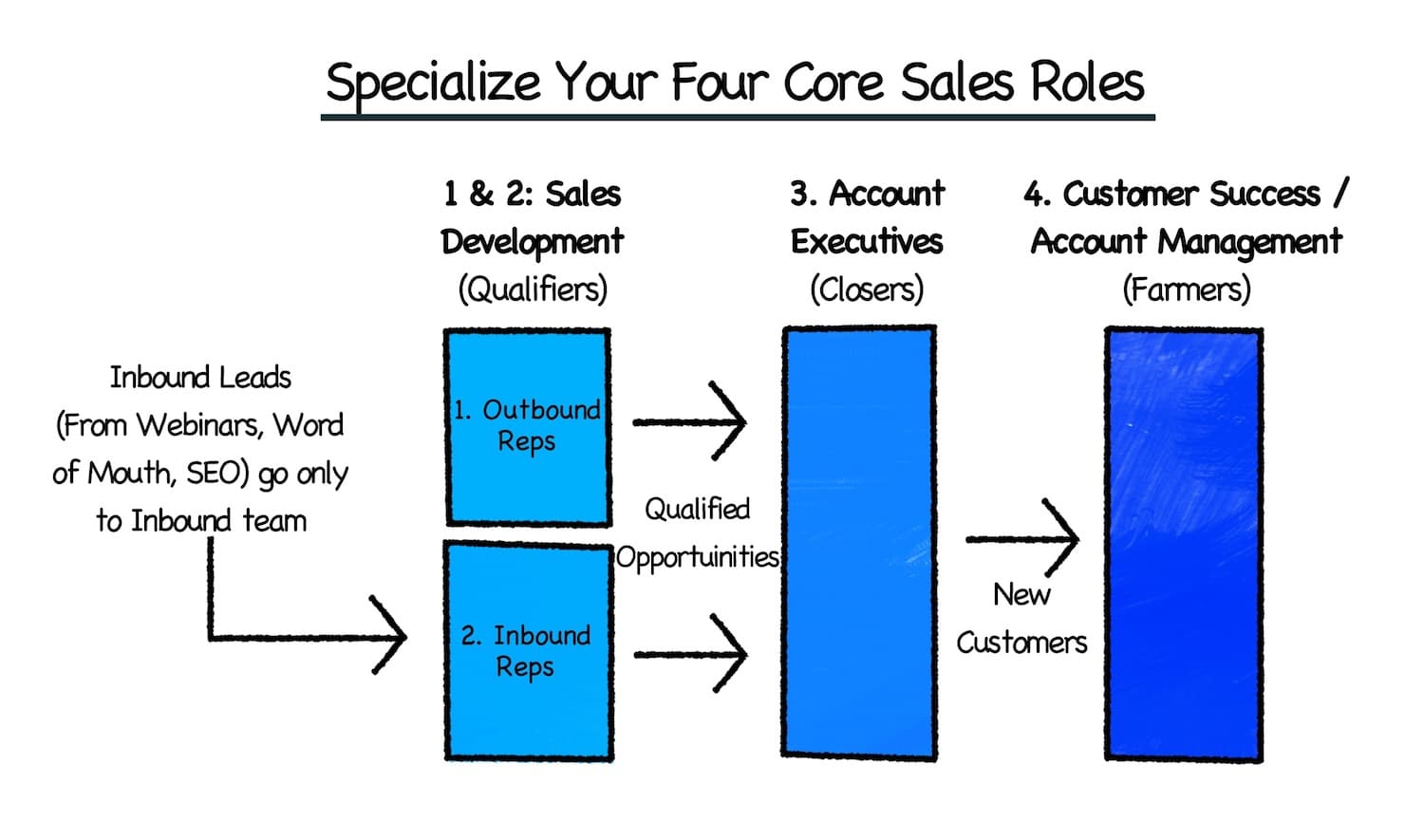
As an organization gets larger, it is possible to get even more specialized. For example, it can often make sense to have different reps for different vertical industries that get to know and understand the customer problems, terminology, and specific vertical messaging. Another type of specialization that can make sense is based on customer size: one group for large accounts, and another for smaller, as their problems and required solutions and messaging are different.
When should companies consider specialization? Are startups too small for this?
I frequently hear “We’re too small to specialize yet.” It is always “sooner than you think,” even if you just have a handful of Account Executives. The second person you hire, after a salesperson who can close, should be a sales rep who is dedicated just to generating leads for your first closer.
A second rule of thumb is the 80/20 rule. When your reps, as a group, are spending more than 20% of their time on a secondary function, break out that function into a new role.
For example, if someone whose primary role is to generate outbound leads begins spending more than 20% of their time qualifying inbound leads, it’s time to look at specializing and creating a separate role just for responding to inbound leads.
Tell us how you uncovered your breakthroughs that led to success in cold calling
In early 2003 I was experimenting with cold calling, to see if it would work. It did – but far too slowly. I had been able to generate 2 qualified leads in a month. To meet my goals I needed to be able to generate 8 qualified opportunities. (This may sound low, but remember that a core principle is to generate fewer opportunities that are much higher quality.)
The First Breakthrough
The first breakthrough I had was realizing that the biggest bottleneck in prospecting into companies isn’t selling the decision maker/influencer/point person…it’s finding them in the first place!
Oftentimes the ultimate decision maker – such as the CEO or VP Sales in the case of Salesforce.com, is not the best person for your initial conversations. I learned this through hard work – cold calling, cold emailing, plugging away. I realized I spent most of my time hunting for the right person – not trying to sell or qualify them.
If I could find the right person, I could usually have a productive business conversation with them. It was just a pain in the ass to find them, especially in the F5000 size companies!
In Desperation, I Tried An Experiment: I’d always assumed that mass emailing executives wouldn’t work. Don’t I need to carefully craft each email to them to make it personal?
- I wrote one email that was a classic salesy cold calling letter: “Do you have these challenges? X, Y Z…”.
- I also wrote a totally “short and sweet” different email simply asking for a referral to the right person at the company. (I won’t be sharing email templates in this book for two reasons, which I will describe in a section just on email).
I remember my experiment like it was yesterday. On a Friday afternoon, I sent two mass emails from Salesforce.com:
- 100 of the “classic salesy” emails to F5000 executives, and
- 100 of the “short and sweet” emails to the same kind of list.
Out of 200 emails I sent, I had 10 responses back! Again, these were from C-level and VP-level executives at large companies.
- Response rate for the “salesy” email: 0%.
- Response rate for the “short and sweet” email: 10%.
And at least five of the emails I received from the short and sweet campaign were positive, referring me to other people in the organization as the best person for a conversation about sales force automation.
The Second Breakthrough
I discovered that mass emailing C-level F5000 executives, with specific kinds of emails, can generate 9%+ response rates. Those high response rates (8-10% or more) from high-level executives have held true year after year, even with my current clients in 2010, seven years later.
The Result: A 500% Increase
In the next month, April 2003, I increased my results by 500% and generated 11 qualified sales opportunities!
Hence the tipping point of the Cold Calling 2.0 process was born: sending mass emails to high level executives to ask for referrals to the best person in their organization for a first conversation.
What does the Cold Calling 2.0 Funnel look like?
This diagram from the book shows a sample funnel that breaks out the prospecting stages:
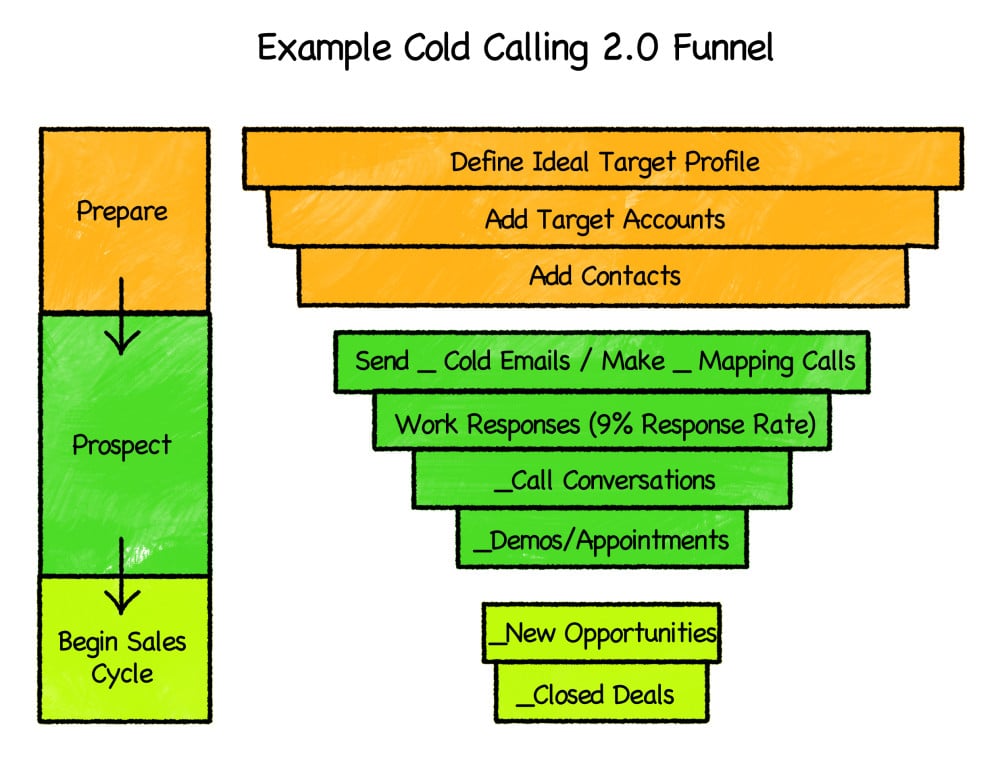
Here is another way to look at the Cold Calling 2.0 process that a sales development rep should be following:
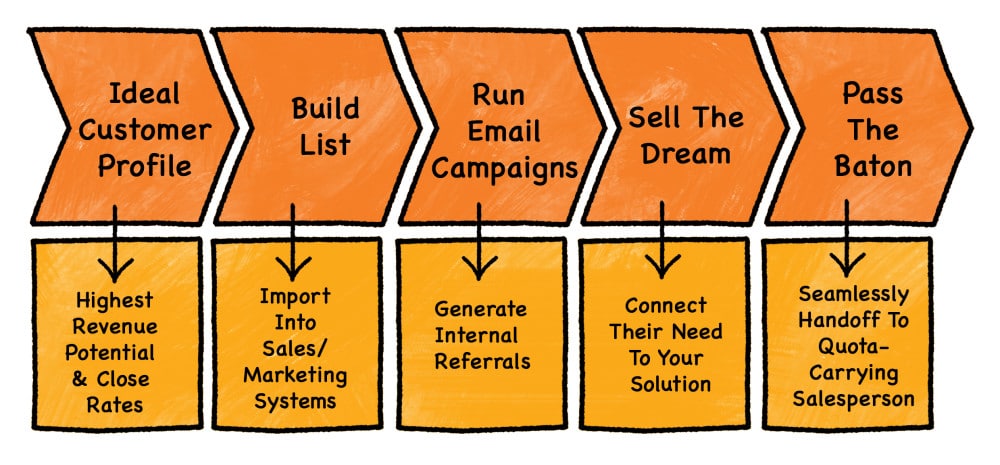
Give us your thoughts on the Ideal Customer Profile (ICP)?
Getting clear on your Ideal Customer Profile, including how to describe them and what their core challenges are, is the most important exercise to maximize the effectiveness of your marketing and sales functions. It helps you:
- Find great prospects more easily through smart targeting
- Disqualifying poor prospects more quickly
…both of which lead us to faster sales cycles and higher win rates. If you are going to implement a cold calling 2.0 process, this is an critically important starting point.
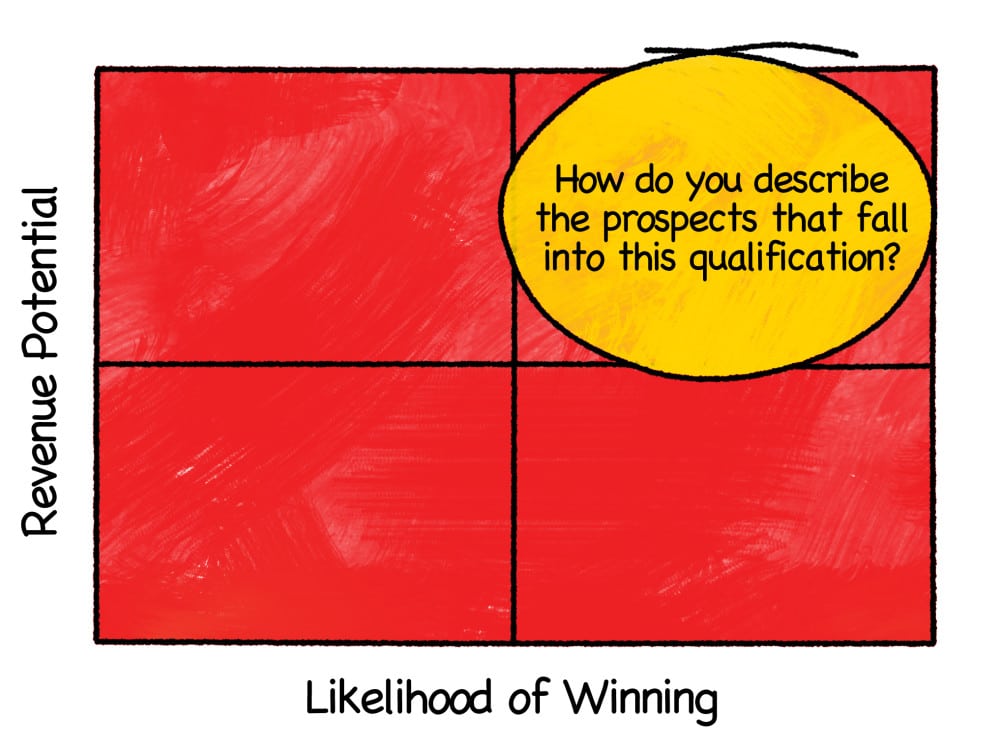
The result of this should be a list of criteria that you want, with an explanation of the reasons why. For an example of one criterion:
| Criteria We Want | Why |
| 25-250 Employees | Our customers have to be large enough to need our service. However, if they are too large, they tend to hire someone in-house to do it full-time. |
The book provides some great examples of how to work through this exercise, and what the output should look like.
What are some more of your guidelines for writing these referral emails?
- It’s important to make it short and sweet
- Don’t sell
- You want to make sure you are asking for just one thing, which is a referral
- Give people enough information, but in a short way. The trick is to being specific enough about who you should talk to, or what you do, in a very short way.
The variables that make this successful:
- Who you are sending it to ?
- What is the subject line?
- How are you asking for the referral?
- How are you describing the person you want to talk to?
- How are you describing what you do?
To get this right will likely require experimentation using A/B testing to optimize.
Don’t Sell
There is always some salesperson or executive who wants to throw in a bunch of salesy stuff (our value, bullet points, attached PDFs) – You have to prevent that. Just keep them away from the process. Trying to sell at this stage will wreck the conversion rate of these emails. It’s like going for coffee with someone on your first date, and you are leaning in for the kiss before you have said hello. (Note from David Skok: I wrote on this topic here: When selling is the worst way to win customers.)
What is the profile of a person who would be good as an SDR?
If you don’t yet have someone doing this already, and you are looking for a person to set it up, you want to find someone who is a problem solver, and who is entrepreneurial. Ideally you want to have someone in your company who would like the opportunity to do this. Best is if you can have two people starting this at the same time, so they leverage the buddy system.
After that, you really just want smart people who can figure things out, who know something about business. Some of my best people didn’t start as salespeople, they had other business experience. They were able to learn sales. They were good at having business conversations. They also need to be able to develop trust, and have high integrity.
They should have a good sense of process, because if you are disorganized, it is not going to be effective. And you’re going to have to like them.
Tell us about your ‘Layers of the Onion’ thinking

The Layers of the Onion idea is all about how to lead a prospect through to becoming a customer. You have to realize that customers want to get to know you in small steps. And they want to feel like they are in control of that process. Think of them as a squirrel. Your job is to lay out tempting morsels one after the other to get them to take another step forward. You can also think of that as being like peeling back the layers of an onion.
The high level concept here is that people need to take multiple steps to get to know you. Sales people need to relax, and stop trying to go for the close so fast. There is not enough patience in the world. This is all about patience and baby steps.
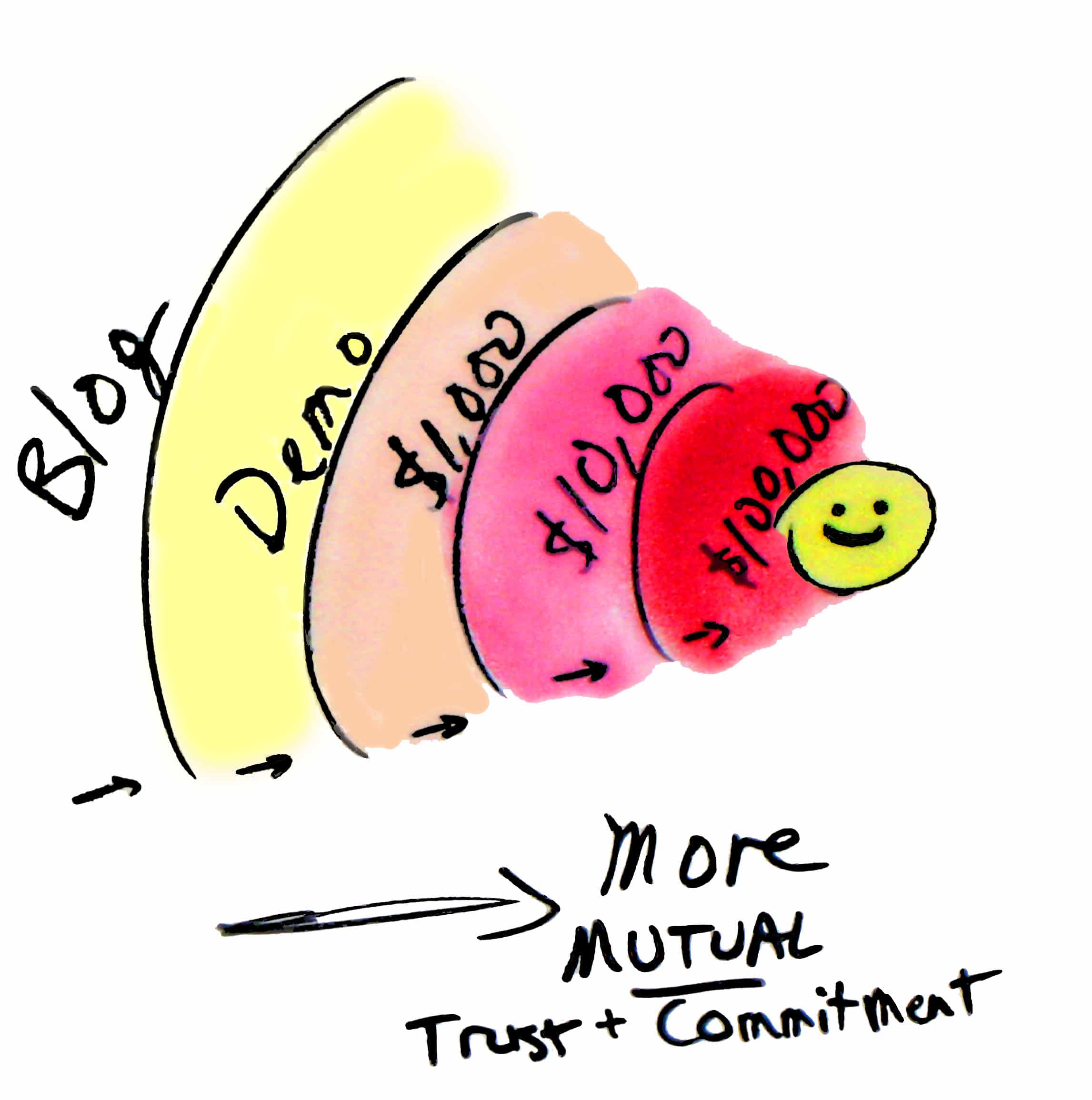
The Internet has drastically shifted power from sellers to buyers. The old way of marketing and selling involved pushing information onto prospects and then working to control their steps along a sales process. Buyers had limited access to information, which they had to negotiate out of sellers. Now, buyers can do more research on their own before they ever talk to a human at a company (if they ever do talk to a human!)
Go with it – let prospects do the work!
Instead of resisting this trend and staying attached to how potential customers used to, or “should” get to know your company, go with it and give the prospects the control over how they want to get to know you.
Present them with a couple of logical next steps and let them decide how and when to move forward (of course, with some helpful reminders now and then if they’ve stalled).
Setting up progressive layers of the onion is key to “receiving sales” or “pulling sales” (much easier than pushing sales). Let the prospects do the work for you!
The layers are mutual – get to know your prospects as they get to know you
The layers enable prospects and vendors to test mutual compatibility with progressive steps of increasing trust and commitment, to minimize the risk and costs of a bad fit to both parties. With the layers of the onion, a prospect can engage right away at the level they feel comfortable with, and then can work their way up the trust & commitment layers as they and you see fit.
As a seller, now you can more easily test out how much of a fit the customer is for you, before you commit extra time or resources to them! Committing to a bad-fit customer is an enormous cost, and the right layers can help you avoid those landmines.
Let go
Give up trying to control how long someone takes to move forward. You’ll have to accept that most prospects that initially sign up for a blog, trial or demo just won’t be ready to do anything. That’s ok – don’t try to force them. But consider if there’s another onion layer you can create to offer to make it easier for them to take another step.
If you see prospects getting stuck somewhere in your “layers”, consider redesigning your next-step offers. What is the next “juicy morsel” they would want if you showed it to them, that would help them take another step forward? What new layers, content or products can you create that are compelling and relevant to who the prospect is and where they are in their evaluation & buying cycle?
Let go of trying to control prospects, and trust that if it’s a good mutual fit, and you keep nurturing them and your “layers” are relevant & useful, they will become a customer someday!
Can you summarize your thoughts?
- You MUST specialize your salespeople, and have, at a minimum, at least one (better is two) outbound reps focused 100% on prospecting – and that means NO CLOSING or inbound lead qualification. If you can’t specialize today, make a plan on how and when you can. You don’t need to be big to begin to specialize; all you need is two people in sales.
- Use a referral/researching approach rather than cold calling people directly. You can generate quality referrals from cold contacts who have never heard of you via short and sweet email templates.
- Focus on QUALITY, not quantity, of actions, calls and leads (fewer, bigger, better). Measure results-based activities (“# Scoping Calls Completed”) as opposed to metrics like dials.
- Train your outbound salespeople to be “businesspeople who can sell”, rather than salespeople. Not only do they need to have a multi-step outbound sales process that works, they also must be able to have an intelligent conversation with high-level executives, whether via email or phone. You can train young people (even out of college) to do this.
- SIMPLIFY what you track in your CRM/SFA system (such as a Salesforce.com), focusing on your few, best metrics (like new $ pipeline created per month, qualified leads per month, etc.) You have to get rid of all your extra junk tracking fields that clutter everything, and simplify your dashboards.
Unfortunately, too many companies won’t take the single most important step to make prospecting work – dedicating an inside sales team or role 100% to prospecting and generating opportunities to pass on to the Account Executives/closers. This is always priority #1!
Sell Ideas, Not Stuff
Aaron says that, in their marketing and prospecting, companies and people do way too much selling. Clients don’t want to buy products, they want help. The best way to help them is with both your product & your expertise So, you must educate rather than sell…as he talks about in this short video:
Selling Your Idea, Not Just Your Product
Conclusion
If you found Aaron’s ideas above interesting, I recommend that you purchase the book. It has a great deal more detail than is covered in this short interview.
This article originally appeared on ForEntrepreneurs.com by David Skok.
Transform your sales strategy with expert guidance. Connect with us for personalized consulting and coaching that turns challenges into opportunities for success.